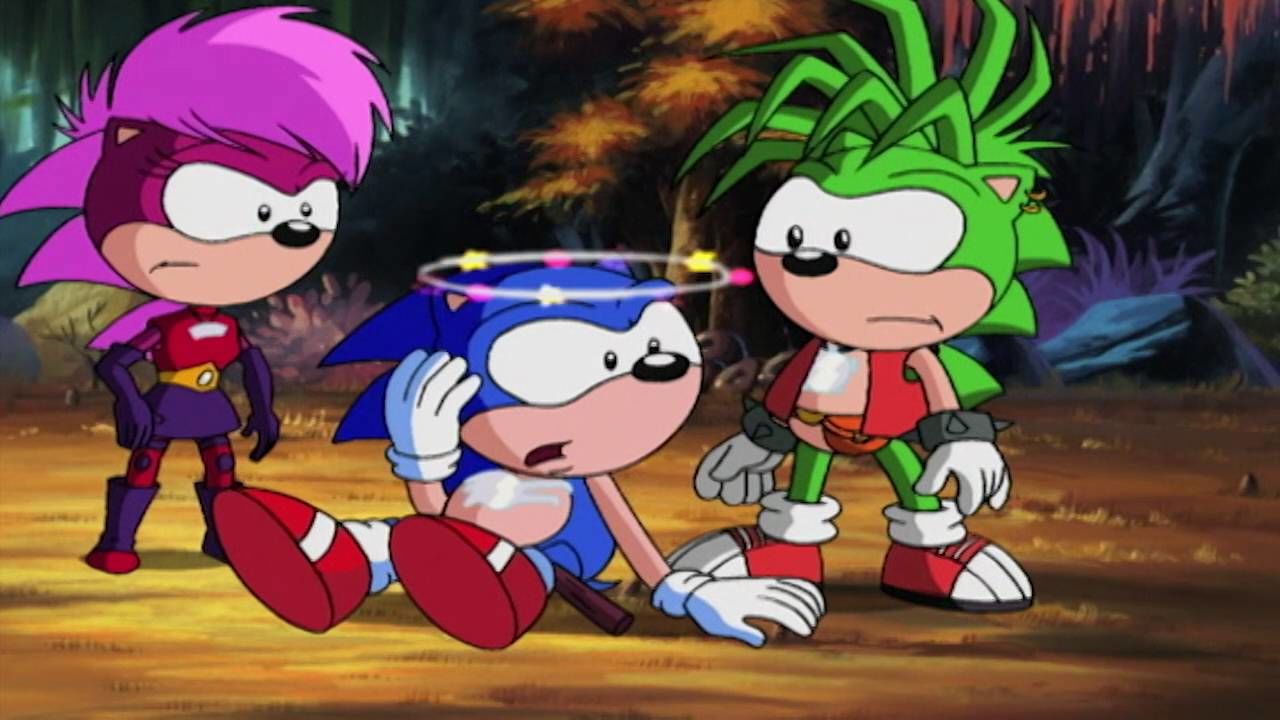Create a free profile to get unlimited access to exclusive videos, sweepstakes, and more!
Nostalgia Bomb: Sonic Underground was peak weird Sonic

When it comes down to it, Sonic the Hedgehog is a simple creature with simple needs. He collects gold rings. He fights Dr. Robotnik. He's gotta go fast.
For the first several years of the character's existence, that was enough to inspire video games, comic book series, and animated cartoons. But by the end of the '90s, Sonic had slowed down, forcing Sega to experiment with the character's core concept. As a result, we got everything from officially sanctioned oddities like the Werehog of 2008's Sonic Unleashed to fan art depicting Sonic's religious conversion and/or his pregnancy.
And then there was the French-produced animated series Sonic Underground, which ran for one 40-episode season from 1999-2000. The muscular vocal track to the show's hard-rock opening theme song lays out the series' premise: After an oracle predicts that Sonic and his siblings Sonia and Manic will free their planet Mobius from the tyrannical Dr. Robotnik, their mother, deposed Queen Aleena, separates her children as infants, leaving them only with magical amulets. The siblings reunite as young adults, leading the rebellion while searching for their mother, whose presence will complete the prophecy and overthrow Robotnik.
SPEED ROCK
While there are some new additions here (royal siblings? magic amulets?), nothing described in the song would be out of place in the Sonic games for the Genesis or in the previous cartoon series Sonic the Hedgehog. Sonic is still a cocky hotshot voiced by Jaleel White, he still goes fast, and he still fronts a rock band.
Oh, did I not mention the rock band? Yeah, in Sonic Underground, Sonic and his siblings form a rock band, playing instruments spawned by their magic amulet. In fact, music becomes the heroes' primary superpower, as every episode features a Scooby-Doo-style music video, in which the trio perform a song about that episode's plot. Yes, Sonic does still go fast — and his siblings have their own abilities, with Sonia's spin attack and Manic's … uh … shoplifting skills — but he saves his speed for eating chili dogs and running away from danger.
In this series, Sonic most often thwarts Robotnik's plans with good ol' rock & roll, sometimes simply irritating baddies with his music and sometimes shooting laser blasts from his instrument. A surprising number of episodes are set in performance spaces for the band, beginning with the pilot "Wedding Bell Blues." In that story, the heroes disrupt Queen Abeena's forced marriage to Robotnik by infiltrating the headquarters dressed as classical musicians and using their music to sabotage the place.
That's strange, to be sure, but it isn't exactly agains the spirit of Sonic as a character. As commercials for the first game made radically clear, Sonic has always been a mascot full of attitude. And, as these ads suggest, its usually an attitude that sounds very much like a middle-aged ad exec's idea of youthful rebellion. From the show's slang ("Give it up, slomo!") to its styles (Manic's ripped denim jacket and spikey hair) to its music, the aesthetics of Sonic Underground aren't futuristic, or even that of the grunge and techno that dominated airwaves in the '90s, when the series was released.
Instead, songs like "Sound of Freedom" from the episode "The Art of Destruction" or "We're the Sonic Underground" from "Tangled Webs" recall '80s arena rock — the stuff the series' producers thought was cool when they were kids (with the occasional outlier, like the country ditty "Built for Speed" from "Winner Fakes All").
SONIC AND HIS STRANGE FRIENDS
It's a lot harder to make sense of the series' other weird choices. As usual, Sonic is joined by a group of allies, but gone are Tails, Amy, and even Big the Cat. Knuckles guest-stars in the three-part "Chaos Emerald Crisis" arc, but he's hardly the rival he is in most Sonic stories.
Instead, Sonic spends most of his time with Sonia and Manic, with occasional assistance from the uptight Sir Bartleby Montclair and fellow freedom fighter Cyrus the Lion. While these characters do, like Sonic's usual pals, join the fight, they more often provide performance space for the Hedgehog siblings because, again, rock & roll is their greatest superpower.
The show's writers compensated for the diminished roster by creating tension among the three leads, as established in the origin episode "Beginnings." There we learn that the siblings were raised in vastly different economic settings. Sonia grew up affluent, Sonic with the middle-class chili dog vendor Uncle Chuck, and Manic among destitute people who had to steal and lie to survive (think Parasite with anthropomorphic animals).
These backgrounds result in a surprising amount of class struggle for a children's cartoon, especially when class becomes the central point of an episode. For example, in "Mobodoon" the oft-homeless Manic considers staying in the titular Brigadoon-like magic city, a decision he defends by citing Sonia's (and even Sonic's) relatively privileged upbringing. Of course, he returns to his family at the end, but I can't think of another '90s cartoon video game adaptation that even considers the proletariat's strife with the bourgeoisie.
However, those big ideas too often fall by the wayside when the stories head to their requisite Sonic vs. Robotnik showdowns, but even that standard conflict plays out differently in Sonic Underground. Dr. Robotnik remains Sonic's archenemy, but his primary henchmen here are the evil genius Sleet (veteran voice actor Maurice LaMarche, doing his best Peter Lorre) and the musclebound Dingo (Peter Wilds).
Most cartoons would be happy with a simple "brains and brawn" pairing, but not Sonic Underground. Instead, Dingo puts his body to work by allowing Sleet to transform him with shapeshifting technology, taking the form of everything from a motorcycle to a chopper to a grotesque baby/football amalgam. It's truly nightmare-inducing stuff that the show simply shrugs off as a normal thing that happens in most adventure stories.
GOTTA GO WEIRD
As these villains demonstrate, Sonic Underground feels like a funhouse mirror of the standard Sonic story. All the key elements are there — a speedy hero resisting the evil Dr. Robotnik's goons — but they play out in a frankly bizarre manner. Here, going fast isn't nearly as important as going weird, even if the show treats its weirdness like normal cartoon fare.
Back in 1999, Sonic Underground seemed like an aberration from renegade animators twisting the characters into something unrecognizable. But now in 2020, as we prepare to watch Jim Carrey ham it up as Dr. Robotnik and Ben Schwartz's Sonic 2.0 pal around with James Marsden, crazy storytelling choices are fundamental to the character. Sonic may have started out as a guy who just runs fast and grabs coins, but Sonic Underground has proven that he can be anything — the weirder the better.


























